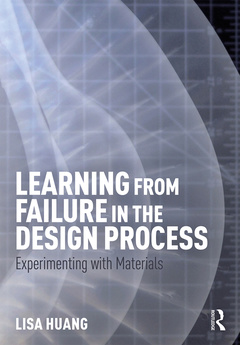Description
Learning from Failure in the Design Process
Experimenting with Materials
Author: Huang Lisa
Language: English
Subject for Learning from Failure in the Design Process:
Keywords
Maison De Verre; building materials; Glass Fiber Reinforced Concrete; concrete; Spheroidal Graphite Iron; sheet metal; Ultra-High Performance Concrete; ceramic tiles; Punta Della Dogana; glass; Material Considerations; CNC Milling Machine; assembly techniques; PVC Fabric; obstinate materials; PVC Membrane; materials misbehaving; Wood Formwork; material assemblies; Le Corbusier Architecte; architectural design; Glass Blocks; material characteristics; ETFE Foil; materials and methods; Le Corbusier; methods of construction; Masonry Assembly; Zaha Hadid Architects; Cast Concrete; CNC Mill; Allianz Arena; De Young Museum; Casting Process; Assembly Technique; Steel Cables; Twa Terminal; Stacked Assembly
Publication date: 04-2020
· 17.8x25.4 cm · Hardback
Publication date: 04-2020
· 17.8x25.4 cm · Paperback
Description
/li>Contents
/li>Readership
/li>Biography
/li>
Learning from Failure in the Design Process shows you that design work builds on lessons learned from failures to help you relax your fear of making mistakes, so that you?re not paralyzed when faced with a task outside of your comfort zone.
Working hands-on with building materials, such as concrete, sheet metal, and fabric, you will understand behaviors, processes, methods of assembly, and ways to evaluate your failures to achieve positive results. Through material and assembly strategies of stretching, casting, carving, and stacking, this book uncovers the issues, problems, and failures confronted in student material experiments and examines built projects that addressed these issues with innovative and intelligent strategies.
Highlighting numerous professional practice case studies with over 250 color images, this book will be ideal for students interested in materials and methods, and students of architecture in design studios.
Acknowledgments
Introduction
Chapter 1: WHY STRETCH?
- What Can We Stretch? Material Considerations
- How Do We Stretch?
Typical Stretching Materials and Components
Key Issues to Consider in Material Selection
Typical Assembly Requirements
1.3 What Happens When Stretching? What Are the Failures/Limitations/Problems We May Encounter?
Composite Assemblies: How Do We Integrate Rigid and Stretched Materials?
[Student Experiment: How Do We Negotiate Between Flexible and Stiff Material Systems?]
Pliability + Sagging: How Do We Overcome the Effects of Gravity and Give Dimension to Flatness and Floppiness?
Alternative Strategies: How Else Can We Take Advantage of a Membrane’s Natural Inclination to Cling and Drape?
Lightness + Weight: How Do We Make a Typically Temporary Assembly Look More Permanent?
[Student Experiment: How Do We Take Advantage of a Material’s Stretching Potential?]
Stretching the Material Itself: How Can We Make Rigid Material Look Soft and Fluid?
Chapter 2: WHY CAST?
2.1 What Can We Cast? Material Considerations
Typical Casting Materials and Components
[Student Experiment: How Do We Cast a Light-transmitting Concrete Panel and What Else Can We Do with It?]
Atypical Casting Materials and Components
Key Issues to Consider in Material Selection
2.2 How Do We Cast? Typical Assembly Requirements
Key Steps in the Process of Casting
Atypical Formwork Strategies
2.3 What Happens When Casting? What Are the Failures/Limitations/Problems We May Encounter?
[Student Experiment: What are Some Missteps That We Confront in the Casting Process?]
Precision + Control: How Do We Accommodate or Outsmart Inevitable Inconsistencies in the Casting Process?
[Student Experiment: How Do We Control Material Behavior in the Casting Process?]
Texture + Unpredictability: How Do We Turn Surface Inconsistencies or Defects into Design Features?
Texture + Exactitude: How Do We Make a Rough Material Look More Refined?
Form + Lightness: How Thin Can We Cast a Material?
Plasticity + Mass: How Else Can We Highlight the Fluidity of a Cast Material?
Chapter 3: WHY CARVE?
3.1 What Can We Carve? Material Considerations
Typical Casting Materials and Components
Key Issues to Consider in Material Selection
3.2 How Do We Carve? Typical Assembly Requirements
3.3 What Happens When Carving? What Are the Failures/Limitations/Problems We May Encounter?
[Student Experiment: What Happens When We Let the Carving Process Dictate Form and Appearance of Components?]
Operation + Composition: How Do We Make Something Predictable Look Unpredictable?
Ornament + Stability: How Do We Maintain and Express Structural Integrity in Carving?
Chapter 4: WHY STACK?
4.1 What Can We Stack? Material Considerations
Typical Casting Materials and Components
Atypical Casting Materials and Components
Key Issues to Consider in Material Selection
4.2 How Do We Stack? Typical Assembly Requirements
Historical Shift from Bearing Wall to Veneer Cladding
4.3 What Happens When Stacking? What Are the Failures/Limitations/Problems We May Encounter?
[Student Experiment: How Else Can We Integrate a Stacked Assembly with Another Material System?]
Lateral Stability + Height: How Do We Increase the Height of an Assembly of Small Modules While Keeping it from Overturning?
Lateral Stability + Height: How Do We Make a Fluid Form Out of Something Rigid?
Pattern + Texture: How Can We Use the Individual Module to Contribute to a Dynamic Collective for the Uniform Monolith?
[Student Experiment: How Can We Transmit Light Through a Monolithic and Opaque Assembly?]
Porosity + Lightness: How Do We Transmit Light Through A Stacked Assembly?
[Student Experiment: How Can We Manipulate a Stacking Module that can Create Different Patterns of Light?]
Mass + Lightness: How Do We Make Something Inherently Heavy Defy Its Own Weight?
Lisa Huang is a practicing architect and assistant professor at the University of Florida School of Architecture, USA. She spent close to a decade working at Office dA in Boston. Lisa has been recognized with honors of the 2016 American Collegiate Schools of Architecture (ACSA)/American Institute of Architects Students (AIAS) New Faculty Teaching Award, and the 2017 Building Technology Educator Society (BTES) Emerging Faculty Award.




